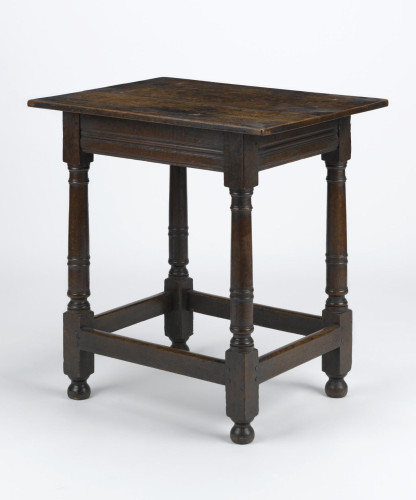99/2008
Collection
Furniture
Brief description
Joined oak table with a rectangular top over a channel-moulded frame, on turned pillar legs joined by a peripheral stretcher, made in England c.1620-1630.
Object name
table
Object number
99/2008
Location
On Display
Production date
c.1620-1630 (manufactured)
Production place
England (manufactured)
Period
Stuart (1603-1714)
Material
oak
Technique
turned
joined
joined
Physical description
Joined oak table, with a rectangular top over a channel-moulded frame, on turned pillar legs joined by a peripheral stretcher, on ball feet, English, c.1620-1630. The table is constructed using scribe joints (a woodworking technique whereby the end of a frame is shaped to neatly fit the contours of the next piece).
The colour is relatively even, although lighter on the top and in areas of wear and darker on less accessible surfaces. The patination is thin and dry, with no evidence of paint or varnish. The underside of the top, the insides of the rails and stretchers and the inner corners of the legs appear untouched, except where it has been handled around the outside edge. The boards on the top have shrunk slightly across their width causing a slim gap to open between them. The corner pegs are flush with the top however although they are old they may not be original. The two other pegs are proud of the top which might suggest some slight movement.
There is a small hole about 5mm diameter in one of the boards which has been plugged with a dowel. This might be an example of the re-use of timber.
The underside of the top shows the kerf marks (the marks left behind by a bladed instrument eg. saw) of a pit saw and the indentations of a needlework clamp. The marks of eight small pins are also visible adjacent to the outer face of the legs, which were presumably used to locate the top while the pegs were being fixed, then withdrawn. All joints are scribed: there is slight wear to the feet.
There are also kerf marks on the inner face of three of the frame rails. The fourth rail has been worked with a side-axe or similar tool, and is perhaps the outside face of the scantling from which the rails were cut (query – quarter?). Two of the legs have sapwood clearly visible on the inside corners; the inside faces of the stretchers are planed clean of kerf marks; all joints are scribed: there is slight wear to the feet.
Object was physically marked with its Object number on 08/02/2010. Marked on the horizontal panel of the table top.
The colour is relatively even, although lighter on the top and in areas of wear and darker on less accessible surfaces. The patination is thin and dry, with no evidence of paint or varnish. The underside of the top, the insides of the rails and stretchers and the inner corners of the legs appear untouched, except where it has been handled around the outside edge. The boards on the top have shrunk slightly across their width causing a slim gap to open between them. The corner pegs are flush with the top however although they are old they may not be original. The two other pegs are proud of the top which might suggest some slight movement.
There is a small hole about 5mm diameter in one of the boards which has been plugged with a dowel. This might be an example of the re-use of timber.
The underside of the top shows the kerf marks (the marks left behind by a bladed instrument eg. saw) of a pit saw and the indentations of a needlework clamp. The marks of eight small pins are also visible adjacent to the outer face of the legs, which were presumably used to locate the top while the pegs were being fixed, then withdrawn. All joints are scribed: there is slight wear to the feet.
There are also kerf marks on the inner face of three of the frame rails. The fourth rail has been worked with a side-axe or similar tool, and is perhaps the outside face of the scantling from which the rails were cut (query – quarter?). Two of the legs have sapwood clearly visible on the inside corners; the inside faces of the stretchers are planed clean of kerf marks; all joints are scribed: there is slight wear to the feet.
Object was physically marked with its Object number on 08/02/2010. Marked on the horizontal panel of the table top.
Dimensions
Height: 69.5cm
Width: 68.4cm
Depth: 50.3cm
Width: 68.4cm
Depth: 50.3cm
Website keywords
tables




